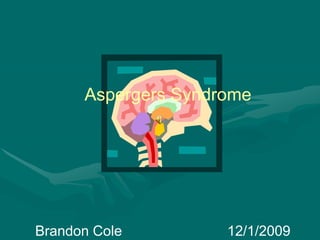
Aspergers Syndrome Guide to Social Cues and Relationships
- 1. Aspergers Syndrome Brandon Cole 12/1/2009
- 2. Imagine… Being unable to understand why someone’s face is dripping water. Being unable to understand why someone is swinging their fist at you.
- 3. Introduction to Aspergers Aspergers Syndrome was first diagnosed by Dr. Hans Asperger in 1944. Children and adults with Aspergers usually have normal intellectual abilities The primary characteristic of Aspergers Syndrome has to do with difficulty with social relationships and communication skills. http://www.behaviorinterventionservices.com/images/behaviors/autism/prevChart.gif
- 4. There are common characteristics that may make having relationships with people with Aspergers difficult People with Aspergers Syndrome often display common characteristics that sometimes are hard to recognize and make it hard to form and have a relationship with them. People can have successful relationships with people who have Aspergers if they are aware of certain things.
- 6. 1c. People with Aspergers often have problems with unspoken social cues Social cues are... “The reading of social cues involves the ability to notice, understand, and act on subtle verbal and nonverbal social messages from others” (Lovecky 2004) Examples of social cues… Facial expressions… Body language
- 7. 2. People can have successful relationships with people who have Aspergers 2a. Using direct speech with people with Aspergers makes relationships with them more successful 2b. Being understanding when someone with Aspergers doesn’t show emotional reciprocity makes relationships more successful.
- 8. A1. Direct speech versus Indirect speech Direct Speech: “Can you turn down the thermostat?” Indirect Speech: “It’s cold in here!”
- 9. 2b. Aspergers and Emotional Reciprocity People with Aspergers may be appreciative but not show it. People with Aspergers may not respond to outward displays of emotion. People with Aspergers often have their own way of expressing emotions.
- 10. The End